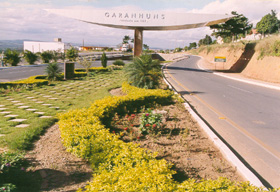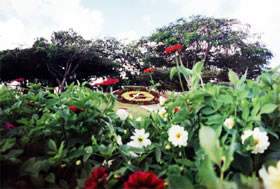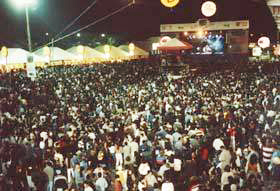|
|
Garanhuns - Pernambuco
«Recife
« Cities of Pernambuco
Population: 117.749 inhabitants (Census 2000)
Distance from Recife: 228 km
Accesses: PE-117,BR-104, PE-126, BR-101 (Palmares route), BR-423 e BR-232 (Caruaru route). Visit the section maps of Recife and Pernambuco for more info.
History
There are three versions about the origin of the name Garanhuns. According to some, Garanhuns comes from
"Uraanhu" which means "man of the countryside" in the indian language. José de Almeida Maciel, respected Brazilian researcher, in his book "Questões de Toponímia Municipal Pernambucana" (On the Toponimy of Cities of Pernambuco), says that the word comes from Guirá-nhum, meaning "Black Birds" in the indian language. Another researcher, Sebastião Galvão, in his "Dicionário Corográfico, Histórico e Estatístico de Pernambuco" (Dictionary of Geography, History and Statistics of Pernambuco), says that it is an indian word meaning "the place of guarás and anuns" (guarás are wild dogs, and anuns are black birds).
The village of Garanhuns was founded on March 10th, 1811. On February 4th, 1879, by force of Law number 1.309, Garanhuns gained status of autonomous city.

Garanhuns has long been an important city of Pernambuco, for its economical and tourist potential (read below). Recently, the city gained national projection for being the hometown of President Luís Inácio Lula da Silva; visit this Lula's biography in the official site of the Presidency (PDF file).
Economy
Distant 228 kilometers from the capital Recife, the municipal district of Garanhuns, also known as the City of Flowers (picture), is also known for being biggest milk distribution center in the State. Garanhuns collects and distributes about 70% of the production of milk and dairy products in Pernambuco; the city is one of the most dairy industry clusters in Brazil. Garanhuns supplies industrialized milk to the North and Northeast regions of Brazil; this industry, which comprehends about 400 productors, is the main source of tax funds in the city.
 The second most important activity is trading. Industry and agriculture, although present, are of lesser economic importance. Tourism is a growing sector (read below).
The second most important activity is trading. Industry and agriculture, although present, are of lesser economic importance. Tourism is a growing sector (read below).
The city of Garanhuns is part of the Development Region of the Southern Agreste, located in the Mesoregion of the Agreste de Pernambuco (see map of Pernambuco), covering an area of 10.828,0 km², representing 10,96% of the State territory. The region it is also constituted by another 25 municipal districts: Águas Belas, Angelim, Bom Conselho, Brejão, Buíque, Caetés, Calçado, Canhotinho, Capoeiras, Correntes, Iati, Itaíba, Jucati, Jupi, Jurema, Lagoa do Ouro, Lajedo, Palmeirina, Paranatama, Pedra, Saloá, São João, Terezinha, Tupanatinga and Venturosa.
The biggest and most expressive economical activity of the Southern Sylvian is the cattle raising (both for beef and milk production). The region is known as dairy basin of Pernambuco.
Besides cattle raising, several subsistence cultures exist in the region, such as beans, corn and manyoc; some more humid zones are propicious for permanent cultures such as coffee and fruits.
Tourism
To newcomers to Garanhuns, it is surprising to find in the middle of the Agreste of Pernambuco an area with cold climate, with architecture and gastronomy in Swiss style.
 With a cozy atmosphere and a well developed hotels infrastructure, Garanhuns welcomes tourists. With a cozy atmosphere and a well developed hotels infrastructure, Garanhuns welcomes tourists.
The explanation to the peculiar climate of Garanhuns is that the city lies among seven hills, on top of the Serra da Borborema, a large montain chain which stretches, under different names, from the inlands of the State of Minas Gerais up to the south of the State of Rio Grande do Norte.
The best time to visit Garanhuns is in July (Brazilian winter), when the climate is perfect for enjoying wine and fondue; during the period, the average temperature is around 18ºC, with lows of 5ºC in places of more altitude (this is cold by Brazilian standards, and VERY cold by standards of the northeast of Brazil).
People from the hot Brazilian northeast have an opportunity to put on scarfs and gloves to attend the Festival de Inverno de Garanhuns (Garanhuns' Winter Festival) (picture), during which every corner of the town has some cultural attraction. During the nine days of the festival, the city is taken by tourists (hotels are full, restaurants are busy).The Winter Feast is the festival wich attracts the largest number of people to the town. Are nine days of plenty wild fun with the attractions that are presented, dayly, in the various poles of fun.
The Relógio das Flores (Flowers' Clock) is the main attraction of the city. Other interesting spots are the the parks Euclides Dourado and Pau Pombo. Two events foster religion tourism: the pilgrimage to the Cristo do Magano, during the Holy Week, and São Sebastião celebration, in January, when over 10 thousand pilgrims cme to Garanhuns.
More info:
Guide of Garanhuns.
Source of information: IBGE and Government of the State of Pernambuco.
Pictures: Government of the State of Pernambuco.
| |